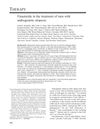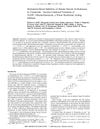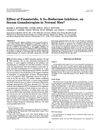TLDR A stronger dual 5α-reductase inhibitor could improve treatment for benign prostatic hyperplasia by further reducing DHT levels.
The document discussed the role of dihydrotestosterone (DHT) and 5α-reductase inhibitors in benign prostatic hyperplasia (BPH). It explained that BPH development was influenced by testicular androgens and aging, with DHT being the key androgen in the prostate. Despite declining plasma testosterone levels in aging men, DHT levels in the prostate remained stable due to the action of the enzyme 5α-reductase, particularly its Type 2 isoenzyme. Finasteride, a 5α-reductase inhibitor, was used to treat BPH and male pattern baldness by reducing DHT levels in the serum by about 70% and in the prostate by 85-90%. While clinical studies confirmed finasteride's effectiveness for BPH, the document suggested that a more potent dual 5α-reductase inhibitor could further decrease DHT levels, potentially improving treatment outcomes for BPH and other DHT-related conditions.
 581 citations
,
October 1998 in “Journal of The American Academy of Dermatology”
581 citations
,
October 1998 in “Journal of The American Academy of Dermatology” Finasteride safely and effectively treats male pattern hair loss, but may cause reversible sexual issues and harm male fetuses.
 1054 citations
,
February 1998 in “The New England Journal of Medicine”
1054 citations
,
February 1998 in “The New England Journal of Medicine” Finasteride reduces urinary issues and surgery need in men with enlarged prostates by over 50%.
 136 citations
,
March 1996 in “Journal of the American Chemical Society”
136 citations
,
March 1996 in “Journal of the American Chemical Society” Finasteride effectively blocks enzyme causing male pattern baldness.
 70 citations
,
June 1993 in “Biochemistry”
70 citations
,
June 1993 in “Biochemistry” Finasteride slowly binds to 5-alpha-reductase, affecting enzyme stability and inhibitor potency.
 1040 citations
,
October 1992 in “The New England Journal of Medicine”
1040 citations
,
October 1992 in “The New England Journal of Medicine” Finasteride effectively treats BPH but may increase sexual dysfunction risk.
 30 citations
,
August 1992 in “The Journal of Clinical Endocrinology and Metabolism”
30 citations
,
August 1992 in “The Journal of Clinical Endocrinology and Metabolism” Finasteride doesn't affect hormone levels in normal men.
 147 citations
,
April 1990 in “The Journal of Clinical Endocrinology and Metabolism”
147 citations
,
April 1990 in “The Journal of Clinical Endocrinology and Metabolism” Finasteride safely lowers DHT levels without affecting testosterone.
87 citations
,
April 1973 in “Endocrinology” The chemicals 17βC and its methyl ester can block the effects of testosterone on hamster skin but not the effects of DHT.
 June 2023 in “Clinica Chimica Acta”
June 2023 in “Clinica Chimica Acta” Finasteride and dutasteride effectively reduce DHT in hair, which may help evaluate their treatment success for hair loss.
 19 citations
,
April 2020 in “Dermatologic Therapy”
19 citations
,
April 2020 in “Dermatologic Therapy” Dutasteride works better than finasteride for hair loss, with both being safe to use.
 January 2015 in “프로그램북(구 초록집)”
January 2015 in “프로그램북(구 초록집)” Dutasteride is effective and safe for treating common hair loss, and it's more potent than finasteride, leading to better hair growth and thickness.
219 citations
,
October 2009 in “Steroids” 5α-reductase inhibitors, like Finasteride and Dutasteride, help manage benign prostatic hyperplasia.
 215 citations
,
November 2006 in “Journal of The American Academy of Dermatology”
215 citations
,
November 2006 in “Journal of The American Academy of Dermatology” Dutasteride more effective for hair growth, but has more side effects than finasteride.
 33 citations
,
October 2005 in “PubMed”
33 citations
,
October 2005 in “PubMed” Dutasteride successfully treated a woman's hair loss when other treatments failed.











